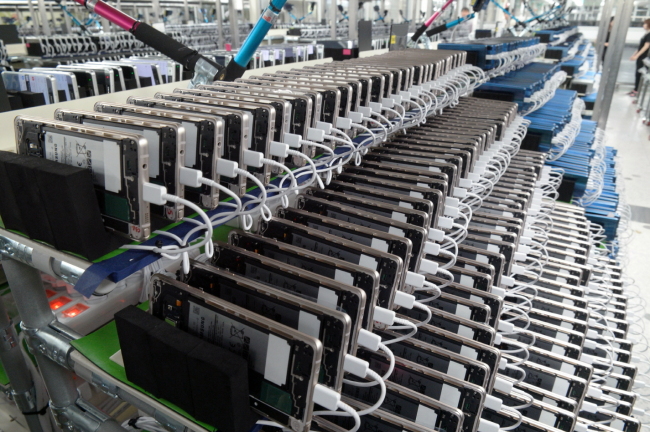Samsung
Samsung probe blames faulty batteries for Galaxy Note 7 fires
[THE INVESTOR] Samsung Electronics on Jan. 23 unveiled its own probe results of the recalled Galaxy Note 7 smartphone, blaming faulty batteries for overheating and explosions of the phone.
The announcement comes more than three months after the Korean tech giant discontinued the fire-prone flagship phone, costing US$5.3 billion in operating profit.
 |
Note phones are tested at a Samsung's research lab. Samsung Electronics |
Samsung’s mobile chief and President Koh Dong-jin apologized again and pledged to come up with follow-up measures, including launching a Battery Advisory Group consisting of external experts, to improve battery safety and innovation.
“Today, more than ever, we are committed to earning the trust of our customers through innovation that redefines what is possible in safety, and as a gateway to unlimited possibilities and incredible new experiences,” Koh said in a press conference held at the Seoul headquarters.
Since the phone’s global recall issued on Oct. 11, 2016, Samsung has poured all-out efforts to find the exact cause of several fires. About 700 Samsung researchers and engineers replicated the incidents by testing more than 200,000 devices and 30,000 batteries, the company said.
The probe was also joined by several independent expert organizations, including UL, Exponent and TUV Rheinland.
The joint investigation team pinpointed faulty batteries as the cause of the accidents. The Note phone used batteries from two manufacturers -- Korea’s Samsung SDI and China’s ATL -- that showed different defects.
Samsung inspected all other factors that could have affected the overheating ranging from hardware defects on rapid charging, water resistance design and iris recognition technology to software and logistics issues.
But the company said it found no problems in those factors.
Then, the company found that charged devices and batteries showed similar burnout rates, focusing its probe on batteries.
“We asked our battery suppliers to improve battery capacity but didn’t properly inspect their functions before the phone’s launch. The ultimate responsibility is ours,” Koh said, declining to specify the names of the battery makers.
By Lee Ji-yoon and Kim Young-won
(jylee@heraldcorp.com) (wone0102@heraldcorp.com)






![[From the Scene] Gigantic Olive Young store lures young trend-setters in Seongsu](http://res.heraldm.com/phpwas/restmb_idxmake.php?idx=151&simg=/content/image/2024/11/21/20241121050065_0.jpg)

